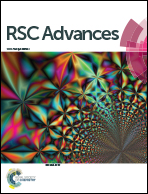NHC macrometallocycles of mercury(ii) and silver(i): synthesis, structural studies and recognition of Hg(ii) complex 4 for silver ion†
Abstract
A series of bis-benzimidazolium (or bis-imidazolium) salts, and their seven N-heterocyclic carbene mercury(II) and silver(I) complexes 2–8, as well as one anionic complex 1 have been synthesized and characterized. In complex 1, two benzimidazole rings point in opposite directions, and π–π interactions between these two benzimidazole rings are observed. In complex 2, two 13-membered macrometallocycles are linked together by one bridging chlorine atom, in which each macrometallocycle is formed by one bidentate carbene ligand (L2) and one Hg(II) ion. In complexes 3–6, each molecule contains one 13-membered macrometallocycle formed by one bidentate carbene ligand and one metal ion. In the crystal packings of 1–8, 1D polymeric chains, 2D supramolecular layers and 3D supramolecular frameworks are formed via intermolecular weak interactions, including hydrogen bonds, π–π interactions and C–H⋯π contacts. Particularly, the selective recognition of Ag+ using 4 as a host compound was studied on the basis of fluorescent and UV/vis spectroscopic titrations.


 Please wait while we load your content...
Please wait while we load your content...